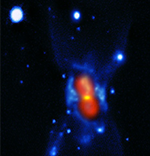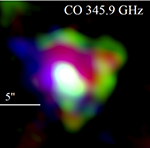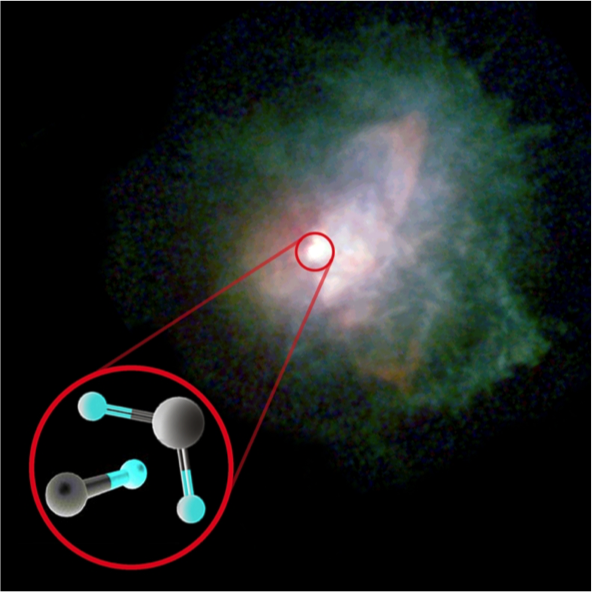Science: Dying Stars
 SMA reveals a molecular remanant of an ancient eruption of CK Vul
The eruption of CK Vul was observed in 1670-72 and had been considered to be a nova. Recent (2014-2015) observations, including maps from the SMA, revealed that the remnant of CK Vul is rich in molecules and dust. The mass and isotopic composition of the material seen in the SMA observations exclude the possibility that the 17th century outburst was a classical nova. Instead, it was proposed that CK Vul eruption was a stellar-merger event.
SMA reveals a molecular remanant of an ancient eruption of CK Vul
The eruption of CK Vul was observed in 1670-72 and had been considered to be a nova. Recent (2014-2015) observations, including maps from the SMA, revealed that the remnant of CK Vul is rich in molecules and dust. The mass and isotopic composition of the material seen in the SMA observations exclude the possibility that the 17th century outburst was a classical nova. Instead, it was proposed that CK Vul eruption was a stellar-merger event.
 Line survey in the 345-GHz band of the peculiar supergiant VY CMa
VY CMa is an evolved massive star with a very high mass-loss rate. The dusty material expelled by the cool star formed an extended and complex nebula which has been studied extensively at optical wavelengths. The Submillimeter Array obtained a spectral-line survey of this oxygen-rich red supergiant between 279 and 355 GHz. 220 lines from 19 molecules and their isotopic species were observed, including for the first time the rotational spectra of TiO, TiO2, and AlCl.
Line survey in the 345-GHz band of the peculiar supergiant VY CMa
VY CMa is an evolved massive star with a very high mass-loss rate. The dusty material expelled by the cool star formed an extended and complex nebula which has been studied extensively at optical wavelengths. The Submillimeter Array obtained a spectral-line survey of this oxygen-rich red supergiant between 279 and 355 GHz. 220 lines from 19 molecules and their isotopic species were observed, including for the first time the rotational spectra of TiO, TiO2, and AlCl.
 Dust-forming molecules in VY CMa
The formation of inorganic (silicates and alumina) dust in circumstellar environments of evolved stars is poorly understood. The Submillimeter Array (SMA) was the first instrument to observe rotational spectra of molecules thought to be most important for the nucleation of dust at elevated temeratures, i.e. close to the stellar photospheres.
Dust-forming molecules in VY CMa
The formation of inorganic (silicates and alumina) dust in circumstellar environments of evolved stars is poorly understood. The Submillimeter Array (SMA) was the first instrument to observe rotational spectra of molecules thought to be most important for the nucleation of dust at elevated temeratures, i.e. close to the stellar photospheres.
